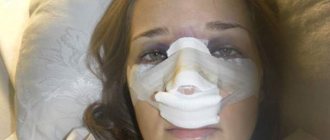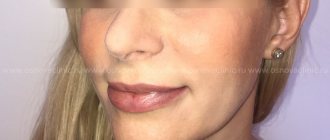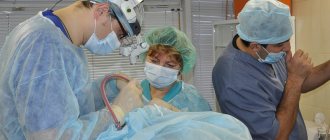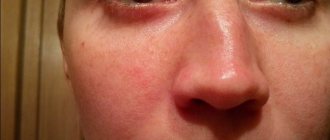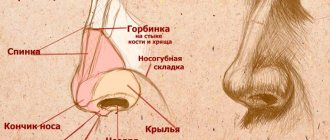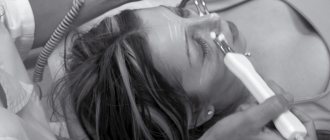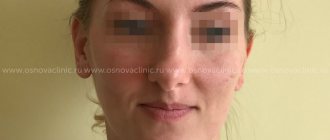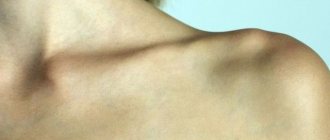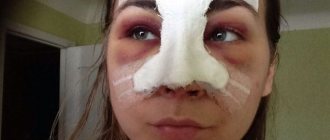Rhinoplasty requires careful preparation patient, the first step in which is a consultation with a plastic surgeon. At this stage, the patient undergoes an examination, the surgeon conducts computer modeling taking into account the patient’s wishes, and the final result of the operation is discussed.
After consultation, the patient undergoes a comprehensive examination aimed at determining his health status, as well as identifying contraindications to rhinoplasty. When discussing contraindications, it should be noted that all restrictions can be divided into absolute and temporary.
Contraindications
Rhinoplasty is not performed if the patient:
- acute inflammation;
- severe chronic systemic diseases;
- immunodeficiency;
- blood clotting disorder;
- cancer;
- allergies to medications used during the procedure.
Contraindications are relative. There is successful experience of operations in patients with insulin-dependent diabetes mellitus, as well as in patients constantly taking blood thinners.
Only a surgeon can decide whether or not to perform an operation, so an initial consultation with the patient is required.
All contraindications can be divided into absolute and temporary
Absolute contraindications for rhinoplasty are those disorders in the human body, serious chronic diseases for which any surgical intervention is impossible. As a rule, such restrictions include diabetes mellitus, heart disease, infectious diseases, diseases of the immune system, chronic liver diseases, cancer, impaired functioning of the bronchi, and blood clotting disorders.
Relative or temporary contraindications to surgical correction of the nose are inflammatory processes of the mucous membrane and sinuses, rhinitis, acute infectious or viral diseases (herpetic rashes), skin inflammatory processes (pustules in the area of the planned operation), recent viral diseases, rhinitis.
If there are time constraints, the patient undergoes additional treatment, after which a full preoperative examination will again be required.
Why us
Full examination before surgery
(including CT scan of the nasal sinuses) to maintain full respiratory function
A complex approach
— doctors work together with ENT surgeons, which allows you to correct the shape of the nose and get rid of breathing problems
Safety
(the clinic has a 24-hour resuscitation service)
Detailed aesthetic analysis of facial proportions and computer modeling
, which allows you to see the possible outcome of the operation
Recovery
in a comfortable hospital
Indications for rhinoplasty
Very often, the reason for rhinoplasty is not a medical indication, but the patient’s desire to improve the shape of the nose to achieve harmony in his appearance. Aesthetic indications for surgery can be divided into objective and subjective. ⠀ Objective are disproportionate and unattractive sizes or shape of the nose. Subjective : there are no specific criteria for assessing beauty, each person has his own established stereotype, and therefore he may simply not like his nose for personal reasons. These 2 reasons often affect professional achievements and personal relationships of people, give rise to complexes of dissatisfaction with oneself, and a feeling of inferiority. Especially among women. ⠀ Aesthetic indications include:
- Disproportional size of the nose in relation to the entire face - too large or, conversely, too small.
- Flared nostrils, hump
- Forked, drooping or too raised, asymmetrical tip, as well as its discrepancy with the height of the back of the nose, saddle shape
- Aesthetically unsatisfactory result of a previous operation
Preparing for surgery
When developing an intervention plan, the surgeon will always aim not only to achieve ideal proportions, but also to preserve individuality, features and improve them. A thorough preliminary examination of the nose and face, computer modeling allows us to provide each patient with a nose shape that will not only meet the wishes, but also fit harmoniously into the appearance, combined with the contour of the chin, the oval of the face, and the lines of the brow ridges.
In a medical operation for nose surgery, there is a preparatory stage, which includes:
- consultation with specialists (plastic surgeon, anesthesiologist, therapist);
- preoperative minimum
The list of tests and procedures includes:
- general urine analysis;
- blood tests (general, biochemical, for infections, for coagulation, for determining the Rh factor);
- ECG;
- computed tomography scan of the nasal sinuses.
Memo for preparing for rhinoplasty: tests, prohibitions, recommendations
Review article about rhinoplasty.
In this article I will talk in detail about how plastic surgeons do rhinoplasty.
I hope my thirty years of experience can help you understand this issue. Let's start with the reasons why patients want to undergo rhinoplasty. And this applies not only to pop stars and Instagram bloggers. There are two reasons why rhinoplasty is performed globally: 1) Poor functioning of the nose, difficulty breathing
2) Aesthetic claims to the shape and size of the nose.
Operation
Nose surgery is most often performed under general anesthesia. The duration of the procedure is usually 2-3 hours. The surgeon’s actions depend on the specific technique and the problem being solved.
The surgery is usually not traumatic, but given the abundant blood supply to the nose, there may be bruising and swelling in the postoperative period. After the intervention, sutures are placed at the incision sites. Most often, nasal packing is not required after surgery.
| In our clinic it is possible to correct several aesthetic imperfections at once in one operation, reducing recovery time. Simultaneous operations are the simultaneous performance of several surgical interventions on different parts of the body, for example, breast augmentation in parallel with nose surgery. During the consultation, the surgeon will determine which operations can be combined taking into account the individual characteristics of the patient. |
Rhinoplasty techniques
- open or closed
- structural
- preserving
- resection
- reconstructive
- audit
With the open technique , an incision is made on the colkmell and is often used to correct significant deformation of the external nose.
The closed technique is used to correct minor defects. In this case, all incisions are made endopsially, without an external incision.
Structural rhinoplasty is usually performed in an open manner using a piezosurgical device. This is a gentle method of rhinoplasty.
Conserving rhinoplasty is the most popular because the dorsum of the nose remains intact and the nose is reduced by removing septal cartilage and complete osteotomy through micro-incisions.
Resection rhinoplasty is the classic method of hump removal when an open roof is formed and a lateral osteotomy becomes necessary. This type of rhinoplasty can be performed using both open and closed techniques.
Reconstructive rhinoplasty is a method of restoring lost structures of the external nose using rotated flaps.
Revision rhinoplasty refers to all those cases where re-operation is required on the structures of the external nose.
Recovery
After the surgical procedure, the patient needs to spend 1-3 days in the hospital. The rehabilitation period depends on the type of surgery. For the first 1-2 weeks, it is necessary to wear a special fixing plaster cast.
For a month, it is necessary to minimize physical activity, exclude sports, bath procedures, and solarium.
The medical team employs specialists with many years of experience and the necessary qualifications. To learn more about the rhinoplasty procedure, sign up for a consultation in St. Petersburg
| Author of the article: Makarov Andrey Vitalievich |
Types of rhinoplasty
Open . It is carried out through an incision in the skin of the bridge between the nostrils. The main advantage of this method is the ability to visually monitor the progress of the operation.
Closed . It is carried out using incisions, as well as through the nasal mucosa. Allows you to avoid the appearance of visible post-operative scars.
Rhinoplasty is a piece of jewelry and an experienced specialist masters and uses both methods according to indications. The type of rhinoplasty is always chosen by the plastic surgeon; he is the one who plans the operation and knows what tasks on the tissues he will have to solve.
Septoplasty is a type of rhinoplasty that corrects the nasal septum. A deviated nasal septum may be the result of a birth injury, an inflammatory disease, or a nasal fracture (if the bones and cartilage have not fused together correctly). Septoplasty can be combined with plastic surgery of the external nose (rhinoseptoplasty).
Rhinoplasty 2
Postoperative period:
- The first 1–2 days after surgery are under the supervision of doctors in the hospital.
- During the first days, antibacterial and painkillers are prescribed.
- Immediately after surgery, a fixation splint is applied to the nose. It will be possible to remove it only after 7–10 days.
- For three days (not always), tampons remain in the nose.
- Swelling and hematomas can persist for up to two weeks.
For two months you should not: sleep on your stomach or side, smoke, wear glasses, play sports, wear clothes with a narrow neck, sunbathe, visit baths and saunas, swim in open water (including a swimming pool), consume too hot or cold dishes.
At first, you need to visit a doctor for an examination and follow all his instructions. It will be possible to return to a more normal lifestyle (including sports) in just six months.
You will be able to see the approximate result of rhinoplasty in a few months, but you will be able to evaluate the final effect of the operation only after 1 - 1.5 years - by this time the soft tissues and the osteochondral complex will have completely healed.
The results of rhinoplasty are stable and long lasting.
Is it painful to have rhinoplasty?
Due to the use of anesthesia (by administering analgesics or being in a state of sleep), the patient feels absolutely nothing during the operation. During rehabilitation after rhinoplasty, there are certain inconveniences, but they are not associated with pain. For example, this is the presence of swelling, tampons in the nose.
It is worth noting that when comparing the majority of rhinoplasty patients with breast reshaping surgery, nose correction is considered absolutely painless.
Rhinoplasty in our clinic
It is carried out in a closed way using a unique ultrasonic piezo apparatus, the so-called laser nose correction. The price of the procedure depends on the volume of the intended intervention. Rhinoplasty is performed without osteotomy, the low-invasiveness of the method ensures a stable result, swelling goes away quickly enough, the plaster is removed within 10-14 days. This way you can correct the hump, straighten the back, correct the tip, narrow the wings, correct the septum to improve breathing, etc. A complete reduction surgery usually takes about 3 hours. It is performed only under general anesthesia. Our patients tolerate anesthesia well and breathe through their nose the very next day after surgery, since internal swelling is insignificant. During the consultation, the plastic surgeon evaluates the client’s anatomy and gets acquainted with the results of a CT scan of the nose (computed tomography of the nose) - a mandatory study before the procedure. Computer modeling of the final result allows you to determine the result. Thanks to the use of a unique ultrasonic piezo knife, the surgeon performs jewelry work. Laser correction of the shape of the nose allows you to make the effect more predictable. The device has several thin attachments, which allow you to work extremely delicately with fabrics. Thanks to this, the technique is considered the most minimally traumatic. To appreciate the final result you need to be patient. The tip is upturned and seems a little snub-nosed, gradually lowers, external swelling goes away, internal swelling disappears (internal swelling can persist for several months and does not cause discomfort), the cartilage grows together, the nose takes on its final shape.
Secondary rhinoplasty
Rhinoplasty is one of the most difficult procedures. Nasal tissues are extremely capricious. Afterwards, it is not recommended to become pregnant for at least a year, since against the background of hormones, the nose may grow and the result of the operation aimed at correction may disappear. Is it true? The uniqueness of our body is sometimes amazing; this phenomenon really exists. Also, do not forget that the nose, like the ears, grows and changes throughout our lives, but this does not mean that surgical intervention requires additional corrections and repeated operations. Why can secondary rhinoplasty be performed? As a rule, due to patient dissatisfaction. The patient’s wishes for the final form are of great importance, which is why we carry out computer modeling. We also recommend looking at the profiles of famous people; we welcome you if you bring photographs of what you ultimately want to the consultation. In this case, the correct approach is important; the surgeon’s task is to determine the feasibility of changes, the possibility of this result according to the patient’s anatomy and the harmony of facial features. And only adequacy and understanding are important from the patient. You can learn all the nuances, risks, and myths during a consultation with our specialists. The doctor will answer all your questions and dispel all possible doubts.
Rehabilitation and recommendations
- Stay in the clinic from 1 to 3 days under round-the-clock supervision of medical personnel. The plaster is removed within 7-10 days.
- Sleep only on your back, do not sleep on your nose – 1-2 months.
- Avoid injury to the nose.
- Limit sports activities – 1 month. Physical activity is encouraged, do not lie down!
- Reduce active facial expressions – 2 weeks.
- Any thermal procedures (baths, saunas, solariums), facial massage, any procedures that displace tissue are prohibited - 2 months.
- Sunbathing is possible after 1 month, protecting the nose area with creams with SPF 50.
- If you wear glasses, you need to switch to lenses - 1 month.
What types of rhinoplasty are there?
There are three types of rhinoplasty, the choice is up to you and the plastic surgeon who will perform the operation. The method by which the correction will be carried out depends on the complexity of the case and the individual characteristics of the patient, the presence of the necessary indications, and the absence of contraindications.
- Open method . The most difficult operation, with a long rehabilitation period. Prescribed when there is a large amount of work. The doctor makes an incision in the columella or nasal cavity.
- Closed rhinoplasty . It is produced by separating the skin from the frame and making the necessary correction. The skin is then stitched together. Today, one of the most common methods for eliminating nasal defects.
- Septoplasty . It is used to correct the nasal septum; the main purpose of the operation is to improve respiratory function.
